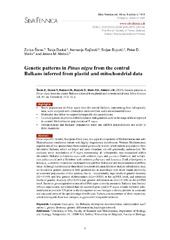Приказ основних података о документу
Genetic patterns in Pinus nigra from the central Balkans inferred from plastid and mitochondrial data
| dc.creator | Šarac, Zorica | |
| dc.creator | Dodos, Tanja | |
| dc.creator | Rajčević, Nemanja | |
| dc.creator | Bojović, Srđan | |
| dc.creator | Marin, Petar D. | |
| dc.creator | Aleksić, Jelena M. | |
| dc.date.accessioned | 2016-05-23T11:00:01Z | |
| dc.date.available | 2016-05-23T11:00:01Z | |
| dc.date.issued | 2015 | |
| dc.identifier.issn | 2242-4075 | |
| dc.identifier.uri | https://radar.ibiss.bg.ac.rs/handle/123456789/2040 | |
| dc.description.abstract | Pinus nigra J.F. Arnold, European black pine, is a typical component of Mediterranean and sub-Mediterranean coniferous forests with highly fragmentary distribution. Western Mediterranean populations of this species have been studied genetically to date, while eastern populations from the central Balkans, which are larger and more abundant, are still genetically understudied. We analyzed seven populations of P. nigra representing all infraspecific taxa recognized within the central Balkans (subspecies nigra with varieties nigra and gocensis Dordevic; and subspecies pallasiana (Lamb.) Holmboe with varieties pallasiana and banatica (Endl.) Georgescu et Ionescu), with three chloroplast microsatellites (cpDNA SSRs) and one mitochondrial (mtDNA) locus. Although our molecular data failed to support circumscription of studied infraspecific taxa, we found that genetic patterns at both genomes are in accordance with those found previously in westward populations of this species, that is - exceptionally high levels of genetic diversity (H-T = 0.949) and low genetic differentiation (G(ST) = 0.024) at the cpDNA level, and moderate levels of genetic diversity (H-T = 0.357) and genetic differentiation (G(ST) = 0.358) at the mtDNA level. Based on genealogical relations of mtDNA types currently present in Balkans' and Iberian/African populations, we inferred that the ancestral gene pool of P. nigra already harbored polymorphism at position 328 prior to the divergence to two lineages currently present in westward and eastward parts of the species range distribution. Subsequent occurrence of three mutations, which distinguish these two lineages, suggests their long-term isolation. | en |
| dc.description.sponsorship | Ministry of Education, Science, and Technology of the Republic of Serbia {[}173029, 173030] | |
| dc.language | English | |
| dc.relation | info:eu-repo/grantAgreement/MESTD/Basic Research (BR or ON)/173029/RS// | |
| dc.relation | info:eu-repo/grantAgreement/MESTD/Basic Research (BR or ON)/173030/RS// | |
| dc.rights | openAccess | |
| dc.rights.uri | https://creativecommons.org/licenses/by-sa/4.0/ | |
| dc.source | Silva Fennica | |
| dc.subject | European black pine | |
| dc.subject | the Balkans | |
| dc.subject | chloroplast microsatellites | |
| dc.subject | mitochondrial nad7 intron 1 | |
| dc.subject | genetic diversity | |
| dc.subject | genetic differentiation | |
| dc.subject | haplotype network | |
| dc.title | Genetic patterns in Pinus nigra from the central Balkans inferred from plastid and mitochondrial data | en |
| dc.type | article | |
| dc.rights.license | BY-SA | |
| dcterms.abstract | Сарац, Зорица; Рајцевиц, Немања; Aлексиц, Јелена М.; Бојовић, Срђан; Додос, Тања; Марин, Петар Д.; | |
| dc.rights.holder | © by the authors | |
| dc.citation.issue | 1415 | |
| dc.citation.volume | 49 | |
| dc.identifier.doi | 10.14214/sf.1415 | |
| dc.identifier.wos | 000365778800015 | |
| dc.type.version | publishedVersion | en |
| dc.identifier.fulltext | https://radar.ibiss.bg.ac.rs/bitstream/id/5590/article1415.pdf |

